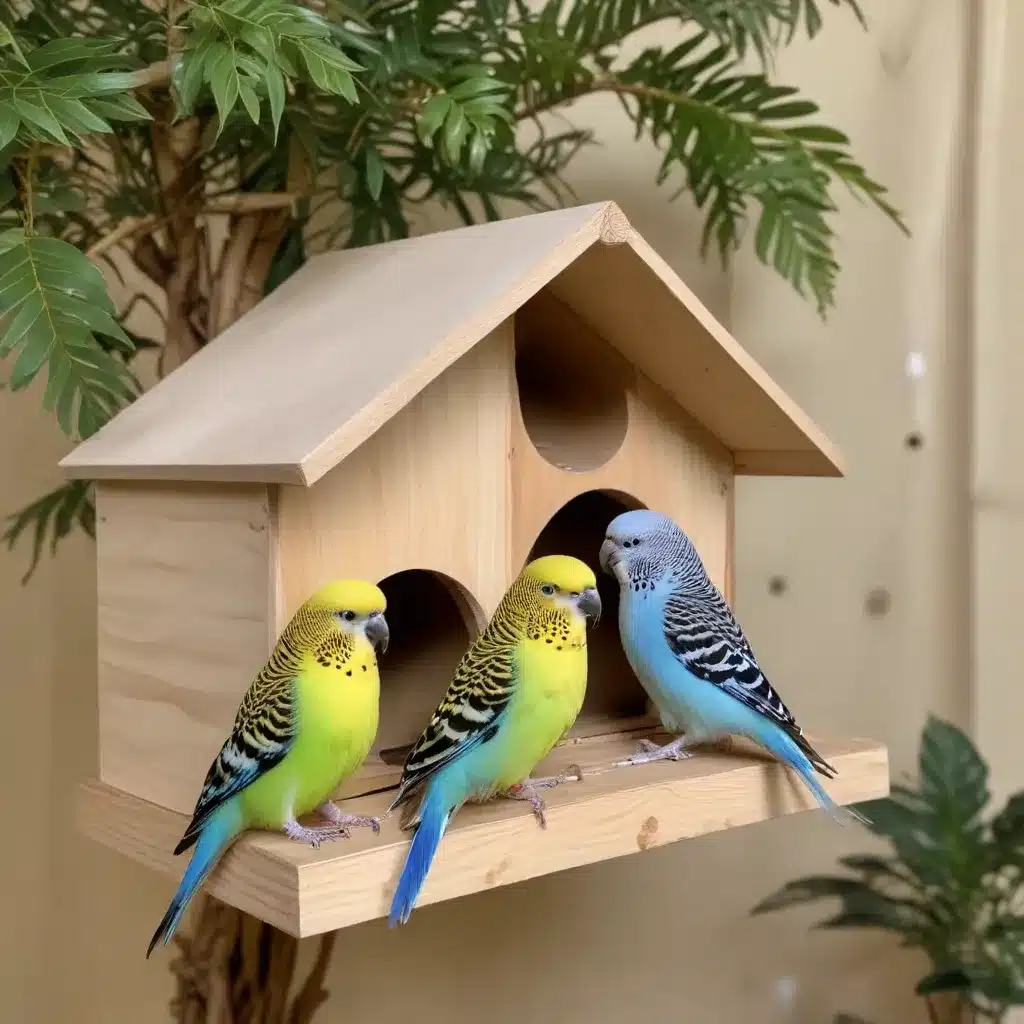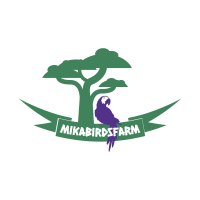
Avian Habitats
Budgies and Their Nesting Needs
As an experienced avian caretaker, I know that budgies, also known as parakeets, have very specific nesting requirements to thrive in captivity. These delightful little birds are social, curious, and energetic, and providing them with a comfortable and enriching living space is essential for their overall well-being.
Budgies are naturally cavity-nesting birds, meaning they seek out enclosed, protected spaces to build their nests and raise their young. In the wild, they would typically find such spaces in the hollows of trees or crevices in rocky outcroppings. When keeping budgies as pets, it’s important to recreate this type of nesting environment to cater to their innate behavioral needs.
Factors in Budgie Bungalow Design
When designing a suitable nesting space, or what I like to call a “Budgie Bungalow,” there are several key factors to consider. The size of the bungalow should be proportionate to the number of budgies in the flock, allowing them ample room to move around, perch, and explore without feeling cramped. The dimensions should provide enough space for the birds to turn around comfortably and have a designated nesting area.
Ventilation is another crucial element, as budgies require a well-aerated environment to prevent respiratory issues and maintain optimal air quality. The bungalow should have strategically placed openings or vents to facilitate airflow without causing drafts or temperature fluctuations.
Budgies also have a strong preference for dark, secluded nesting spots, so the bungalow design should incorporate a sense of privacy and seclusion. This can be achieved by including a covered or partially enclosed area within the structure, allowing the birds to feel safe and secure.
Budgie Bungalow Construction Materials
When it comes to the materials used in constructing a Budgie Bungalow, it’s essential to select safe, durable, and bird-friendly options. Avoid using any materials that could potentially harm the birds, such as toxic paints, sealants, or sharp edges.
Natural wood, such as untreated pine or cedar, is an excellent choice as it is sturdy, easy to clean, and can be shaped to create the desired nesting environment. Plywood or solid wood panels can also be used to build the bungalow’s structure, ensuring it can withstand the weight and activity of the budgies.
For the interior, soft, natural materials like cotton, burlap, or shredded paper can be used to line the nesting area, providing a cozy and comfortable substrate for the birds to nest in. It’s important to regularly replace and replenish these materials to maintain a hygienic and inviting environment.
Budgie Behavior and Enrichment
Budgie Nesting Behaviors
Budgies are highly social birds and often form strong pair bonds. When provided with a suitable nesting space, they will engage in a variety of nesting behaviors that are crucial for their overall well-being. These behaviors include nest building, egg laying, incubation, and chick rearing.
Observing your budgies’ nesting behaviors can provide valuable insights into their physical and psychological needs. For example, if a pair of budgies starts to display courtship behaviors, such as feeding each other or engaging in mutual preening, it may be a sign that they are ready to start breeding and require a dedicated nesting area.
Budgie Foraging and Exploration
In addition to their nesting needs, budgies are also naturally inclined to forage and explore their environment. Providing them with opportunities to engage in these behaviors is essential for their mental stimulation and overall well-being.
Within the Budgie Bungalow, you can create designated foraging areas by incorporating a variety of perches, ladders, and toys that encourage the birds to climb, jump, and investigate their surroundings. Scatter-feeding their diet throughout the bungalow can also encourage natural foraging behaviors.
Engaging Budgies in Their Homes
To ensure that your budgies are not only comfortable but also actively engaged in their Budgie Bungalow, it’s important to incorporate various forms of enrichment. This can include introducing new toys, rearranging the layout of the bungalow, and providing a variety of textures and materials for the birds to interact with.
By encouraging your budgies to explore, climb, and play, you can help prevent boredom, stress, and potential behavioral issues. Regular observation and adjustments to the bungalow’s setup can help you identify the specific preferences and needs of your feathered friends.
Avian Health and Wellbeing
Budgie Comfort and Safety
Maintaining the Budgie Bungalow in a clean, safe, and comfortable condition is essential for the overall health and well-being of your feathered companions. Regularly cleaning the bungalow, disinfecting perches and nesting areas, and replacing soiled substrate can help prevent the buildup of harmful bacteria and the spread of potential illnesses.
It’s also crucial to ensure that the bungalow is free from any sharp edges, loose parts, or other hazards that could potentially harm the budgies. Carefully inspecting the structure and making necessary modifications can help create a secure and safe environment for your birds.
Budgie Psychological Needs
In addition to physical comfort, budgies also have specific psychological needs that must be addressed. Providing them with a stimulating and enriching environment, as mentioned earlier, can help fulfill their natural behaviors and prevent the development of behavioral issues.
Monitoring your budgies’ behavior and ensuring that they have opportunities for social interaction, exploration, and play can contribute to their overall well-being and happiness. Addressing any signs of stress or anxiety, such as excessive feather plucking or aggression, can also help maintain a healthy and thriving flock.
Maintaining Healthy Budgie Environments
Sustaining a healthy and thriving Budgie Bungalow requires ongoing maintenance and monitoring. This includes regularly checking the temperature, humidity, and ventilation levels to ensure they remain within the optimal range for budgie comfort and well-being.
Maintaining a balanced and varied diet, providing clean and fresh water, and monitoring for any signs of illness or parasites can also play a crucial role in maintaining the overall health of your budgies. By staying vigilant and proactive, you can help ensure that your feathered friends enjoy a long and fulfilling life in their Budgie Bungalow.
Sustainable Budgie Bungalow Solutions
Environmentally-Friendly Materials
As an avid supporter of sustainable practices, I believe it’s important to consider the environmental impact of the materials used in constructing Budgie Bungalows. Whenever possible, opt for eco-friendly options that are renewable, biodegradable, and have a minimal carbon footprint.
For example, using untreated, sustainably sourced wood, such as bamboo or reclaimed lumber, can provide a durable and natural foundation for the bungalow. Natural fiber materials like hemp, jute, or organic cotton can also be used for the interior lining and nesting areas, ensuring a safe and comfortable environment for your budgies.
Minimizing Budgie Bungalow Waste
To further reduce the environmental impact of Budgie Bungalows, it’s essential to consider ways to minimize waste and maximize the longevity of the structures. This can include designing the bungalow in a modular or customizable way, allowing for easy disassembly, cleaning, and reassembly.
Additionally, incorporating recycled or repurposed materials, such as upcycled wood or fabric scraps, can help reduce the overall waste generated during the construction process. By being mindful of the materials used and the end-of-life considerations, you can contribute to a more sustainable avian housing solution.
Budgie Bungalow Reusability and Recycling
When the time comes to retire or replace a Budgie Bungalow, it’s important to explore options for reusing or recycling the materials. If the bungalow is still in good condition, consider passing it on to another budgie owner or exploring ways to repurpose it for a different use.
For components that can no longer be used, research local recycling programs or organizations that specialize in the responsible disposal of avian-related materials. By taking a holistic approach to the lifecycle of a Budgie Bungalow, you can contribute to a more sustainable and environmentally conscious avian care industry.
At the end of the day, providing your budgies with a comfortable, engaging, and sustainable living space is not only crucial for their well-being but also reflects our collective responsibility as avian caretakers. By designing and maintaining Budgie Bungalows that cater to the unique needs of these delightful birds, we can ensure their long-term health and happiness while minimizing our impact on the environment. Let’s work together to create a world where budgies can thrive in their cozy, eco-friendly Bungalows.


